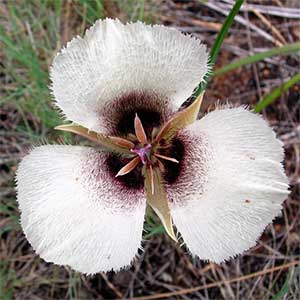Calochortus umpquaensis
Calochortus venustus
Umpqua mariposa-lily
butterfly mariposa lily, square mariposa tulip
not branching, straight, often scapelike, 2–3 dm, glabrous or glaucous.
usually branching, 1–6 dm.
basal solitary, clasping;
blade narrowly lanceolate, hairy, adaxially hispid, abaxially glabrous, sometimes glaucous. Inflorescences 1–several-flowered;
bracts 2, suboppo-site, narrowly lanceolate.
basal withering, 1–2 dm;
blade linear.
subumbellate, 1–6(–10)-flowered;
bracts 2–8 cm.
erect;
perianth open, campanulate;
sepals lanceolate-acuminate, ca. 2 cm;
petals white to cream, with dark purple-black, pentagonal to lunate blotch, broadly oblong to obovate, 3.5 cm, bearded, adaxial surface typically minutely papillose, margins erose;
glands transversely oblong-lunate, slightly depressed, with 0.7–1.4 mm-wide band of short dendritic hairs distally, hairs surrounded by lime-green coloration and purple striations;
anthers lanceolate, apex acuminate.
erect;
perianth open, campanulate;
sepals lanceolate, 3–5 cm, apex recurved;
petals white to brightly or deeply yellow, purple, or dark red, with dark red median blotch, often with second paler distal blotch, obovate or cuneate to clawed, rounded, 3–5 cm, with scattered proximal hairs, apex retuse to obtuse;
glands in lower middle of petal, ± square, sometimes ovate, not depressed, covered with short, orange to red-purple hairs;
filaments usually equaling anthers;
anthers linear-lanceolate to oblong.
nodding, 3–5.4 cm.
erect, linear, angled, 5–6 cm.
2.8–3.5 mm, with inflated bulbous crest and hollow lateral ridge.
light beige, ± flat, 4–6 mm.
= 20.
= 14.
Calochortus umpquaensis
Calochortus venustus
Of conservation concern.
Calochortus umpquaensis is known only from Watson and Ace Williams mountains on both sides of the Little River, Douglas County.
(Discussion copyrighted by Flora of North America; reprinted with permission.)
Flower color and pattern are very showy and exceedingly variable in Calochortus venustus.
(Discussion copyrighted by Flora of North America; reprinted with permission.)
